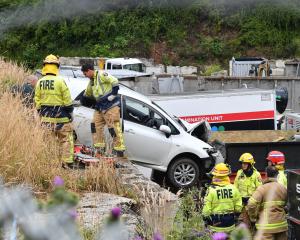The report "The Natural Hazards of South Dunedin'' - prepared by the council's engineering, hazards and science director, Dr Gavin Palmer, and to be tabled at tomorrow's council technical committee meeting - shows the extent of sea level rise effects on South Dunedin.
Average sea level rise of as little as 11cm would result in many properties between Hargest Cres and Bay View Rd being flooded with up to 20cm of water while Tonga Park and Bathgate Park would be almost entirely inundated.
Sea level rise of 60cm would result in much of western St Kilda and Forbury being covered in water, while areas of Musselburgh would suffer ponding of up to 50cm and up to 30cm would be seen in parts of Tainui.
The scenarios were based on what would be expected on a sunny day based on current data and assuming no interventions were taken, Dr Palmer said.
But the clock is ticking with Parliamentary Commissioner for the Environment Jan Wright last year indicating a 30cm sea level rise was the minimum expected over the next 50 years.
Dr Palmer said, while the report stopped short of estimating timeframes for the inundation of South Dunedin, "we are talking about decades''.
"The work confirms what is generally understood.
"If the sea level rises, there will be a rise in groundwater levels and that eventually leads, if there is no intervention, to surface ponding,'' he said.
Surface flooding would not only affect South Dunedin but other coastal areas of Otago, such as the Clutha River delta, he said.
However, the challenge in South Dunedin was exacerbated by the area's population.
The area is home to about 10,000 residents, 12 schools and six rest-homes and much of its about 600ha sits at less than 3m above average sea level.
Research showed annual average sea level rises of 1.3mm between 1900 and 2008, and that was expected to accelerate throughout this century.The risk of groundwater flooding was further elevated by rainfall events with heavy rainfall expected to occur more frequently as the atmosphere heated and held more moisture.
"Heavy rainfall events, similar to those observed in recent years, could ... become a more common occurrence, as the annual mean temperature in the eastern South Island is predicted to increase by about 2degC over the 21st century,'' the report said.
The issue was further complicated as Dunedin's aged wastewater and stormwater systems mitigated issues at present, however, many of the cracked and poorly-joined pipes were marked for renewal.
Direct inundation of parts of South Dunedin from Otago Harbour was also expected to become a more frequent and destructive concern as sea level rises and storm frequency increased.
The various issues facing the area meant the "time is right'' for a community conversation about how to minimise and overcome the issues facing South Dunedin, council chief executive Peter Bodeker said.
The findings presented in the report should only mark
the beginning of a decision-making process.
"While this further work is important, it must be the catalyst for bold decisions about risk management rather than these reports just gathering dust on a shelf,'' he said.
"The work also has to be co-ordinated between agencies and focus on the right issues, in the right sequence, at the right time.
"We believe it is critical the community understands the current and future hazardscape of South Dunedin and we will be presenting this information to the community over the next two months.
"We are also firm in our belief that planning for South Dunedin's future management is an immediate priority.''
The ORC and Dunedin City Council were working in conjunction to present the report's conclusions to the community and to decide the next steps required for planning for the area's future.












